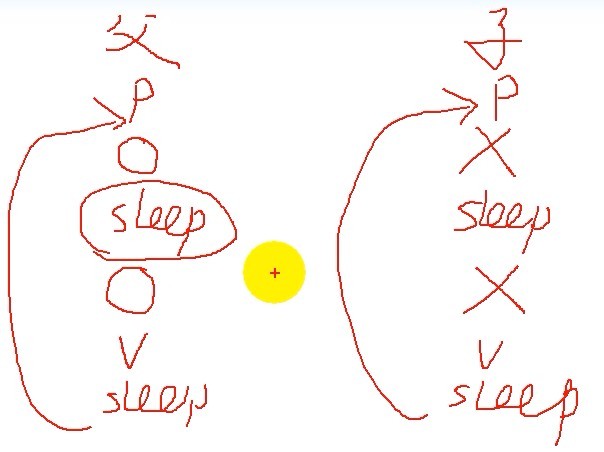一、我们在前面讲进程间通信的时候提到过进程互斥的概念,下面写个程序来模拟一下,程序流程如下图:
即父进程打印字符O,子进程打印字符X,每次打印一个字符后要sleep 一下,这里要演示的效果是,在打印程序的边界有PV操作,故每个进程中间sleep 的时间即使时间片轮转到另一进程,由于资源不可用也不会穿插输出其他字符,也就是说O或者X字符都会是成对出现的,如OOXXOOOOXXXXXXOO....
程序如下:
#include<sys/types.h>
#include<unistd.h>
#include<errno.h>
#include<sys/ipc.h>
#include<sys/sem.h>
#include<sys/wait.h>
#define ERR_EXIT(m) \
do { \
perror(m); \
exit(EXIT_FAILURE); \
} while(0)
union semun
{
int val; /* Value for SETVAL */
struct semid_ds *buf; /* Buffer for IPC_STAT, IPC_SET */
unsigned short *array; /* Array for GETALL, SETALL */
struct seminfo *__buf; /* Buffer for IPC_INFO (Linux-specific) */
};
int semid;
/* pv操作之间的临界区,导致打印的字符一定是成对出现的 */
void print(char op_char)
{
int pause_time;
srand(getpid());
int i;
for (i = 0; i < 10; i++)
{
sem_p(semid);
printf("%c", op_char);
fflush(stdout);
pause_time = rand() % 3;
sleep(pause_time);
printf("%c", op_char);
fflush(stdout);
sem_v(semid);
pause_time = rand() % 2;
sleep(pause_time);
}
}
int main(void)
{
semid = sem_create(IPC_PRIVATE);
sem_setval(semid, 1);
pid_t pid;
pid = fork();
if (pid == -1)
ERR_EXIT("fork");
if (pid > 0)
{
print('o');
wait(NULL);
sem_d(semid);
}
else
{
print('x');
}
return 0;
}分析一下:semval = 1,假设父进程先被调度执行,父进程先P了一下,此时 semval = 0,子进程在父进程睡眠时间被调度的时候尝试P,semval = -1,然后子进程阻塞了,父进程打印完V了一下,semval = 0,唤醒子进程,子进程的P操作返回,打印字符睡眠后V了一下,semval = 1。当然在子进程睡眠的时候父进程可能也在尝试P,故就一直循环往复下去。
二、哲学家就餐问题的描述可以参考这里,下面我们尝试解决这个问题的方法是:仅当一个哲学家两边筷子都可用时才允许他拿筷子。
上图中红色数字表示哲学家的编号,总共5个哲学家,用5个进程来表示;黑色数字表示筷子的编号,总共有5根筷子,可以定义一个信号量集中含有5个信号量,每个信号量的初始值为1,当某个哲学家可以同时得到两根筷子(同时P两个信号量返回)时可以用餐,否则阻塞等待中。用餐后需要同时V一下两个信号量,让其他进程可以P成功。
程序如下:
#include<stdio.h>
#include<stdlib.h>
#include<sys/ipc.h>
#include<sys/msg.h>
#include<sys/types.h>
#include<unistd.h>
#include<errno.h>
#include<sys/ipc.h>
#include<sys/sem.h>
#include<sys/wait.h>
#define ERR_EXIT(m) \
do { \
perror(m); \
exit(EXIT_FAILURE); \
} while(0)
union semun
{
int val; /* Value for SETVAL */
struct semid_ds *buf; /* Buffer for IPC_STAT, IPC_SET */
unsigned short *array; /* Array for GETALL, SETALL */
struct seminfo *__buf; /* Buffer for IPC_INFO (Linux-specific) */
};
int semid;
#define DELAY (rand() % 5 + 1)
void wait_for_2fork(int no)
{
int left = no;
int right = (no + 1) % 5;
struct sembuf buf[2] =
{
{left, -1, 0},
{right, -1, 0}
};
semop(semid, buf, 2);
}
void free_2fork(int no)
{
int left = no;
int right = (no + 1) % 5;
struct sembuf buf[2] =
{
{left, 1, 0},
{right, 1, 0}
};
semop(semid, buf, 2);
}
void philosopere(int no)
{
srand(getpid());
for (; ;)
{
printf("%d is thinking\n", no);
sleep(DELAY);
printf("%d is hungry\n", no);
wait_for_2fork(no);
printf("%d is eating\n", no);
sleep(DELAY);
free_2fork(no);
}
}
int main(void)
{
semid = semget(IPC_PRIVATE, 5, IPC_CREAT | 0666);
if (semid == -1)
ERR_EXIT("semget");
union semun su;
su.val = 1;
int i;
for (i = 0; i < 5; i++)
{
semctl(semid, i, SETVAL, su);
}
int no = 0;
pid_t pid;
for (i = 1; i < 5; i++)
{
pid = fork();
if (pid == -1)
ERR_EXIT("fork");
if (pid == 0)
{
no = i;
break;
}
}
philosopere(no);
return 0;
}需要对一个信号量集中的多个信号量操作时,要么全部执行,要么全部不执行,即是一个原子操作,某个进程需要等待两根筷子,即对两个信号量同时P成功才可以用餐,信号量的序号是0~4,可看作筷子的编号,此时semop 函数操作的是2个信号量,即需定义2个struct sembuf 结构体成员的数组 struct sembuf buf[2];
simba@ubuntu:~/Documents/code/linux_programming/UNP/system_v$ ./dinning
0 is thinking
3 is thinking
2 is thinking
4 is thinking
1 is thinking
4 is hungry
4 is eating
0 is hungry
3 is hungry
1 is hungry
1 is eating
2 is hungry
3 is eating
4 is thinking
1 is thinking
0 is eating
4 is hungry
0 is thinking
1 is hungry
1 is eating
3 is thinking
4 is eating
0 is hungry
1 is thinking
2 is eating
0 is eating
4 is thinking
2 is thinking
1 is hungry
3 is hungry
3 is eating
0 is thinking
2 is hungry
1 is eating
4 is hungry
................
如果发现程序没有运行卡着,即没有发生死锁现象,从中也可以发现同时最多只能有两个哲学家一起用餐,也不会出现相邻哲学家一起用餐的情况。

